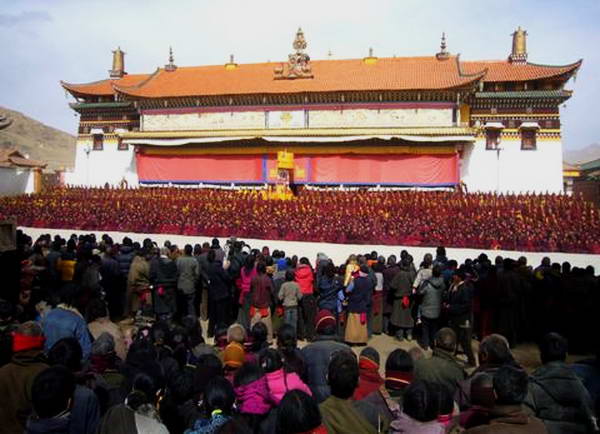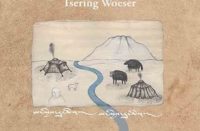High Peaks Pure Earth has translated a blogpost by Woeser written on April 19, 2011 for the Tibetan service of Radio Free Asia and posted on her blog on April 27, 2011.
The unrest in Ngaba, Eastern Tibet, the subject of this blogpost, has been ongoing since the self-immolation of young monk, Phuntsog, from Kirti Monastery – on whom Woeser wrote in a previous blogpost. Woeser also wrote a poem dedicated to another Kirti monk who was detained on March 25, 2011, in Beijing. In this blogpost, Woeser also remembers another monk from Amdo’s Labrang Monastery, Jamyang Jinpa, who died on April 3, 2011, due to torture in detention following his protest in front of foreign journalists at his monastery in April 2008.
The most recent report from Ngaba was released two days ago by International Campaign for Tibet, to read, follow the link.

On March 16, after the young monk Phuntsog died from self-immolation, over a thousand military police armed to the teeth surrounded the unarmed and defenseless Kirti Monastery. Starting from March 20, cadres and officials from all levels of Sichuan as well as Ngaba region and county took over 2500 monks through “patriotic education”; it is said that high officials from Beijing had hurried down to issue such strict instructions.
This “education” didn’t spare anyone. The monks in the monastery were divided into four groups and the armed police and cadres also separated into four work teams, supervising every single person, meticulously registering every single monk. In fact, the word “supervise” is too moderate; they monitored them, talked to them insistently and forced them to obey. If someone did not obey, well, the outcome would be very simple, they would brutally start beating them and then make them disappear; as for where they would disappear to, whether to prison or some other inhuman world, we do not know, we only know that up to now, hundreds of monks have been arrested. More than ten days ago, the news from a different monastery in Amdo, Labrang Monastery, arrived that the monk Jamyang Jinba had died from torture and other savage treatments. Three years ago, he was arrested for 15 days because he petitioned for peace and when he was released he had not only lost his sight in both eyes, every single bone in his body had been smashed to bits.
Not a single government official made their position known publicly or explained why the situation in Ngaba was this grim. On the contrary, they still preach how incredibly happy Tibetans are, how much freedom and human rights they enjoy, and how grateful they are to the Party etc; not a single word has been said about Kirti Monastery being surrounded. But on top of the presence of massive military force guarding the monastery, they even put up barbed wire netting, piled up sandbags, and erected watchtowers, thus setting up a defense structure, far exceeding that of an ordinary prison and more resembling a war-time concentration camp.
It has already been going on for a whole month; the monastery is unable to hold any normal Buddhist classes; the monks are unable to meditate or engage in religious practices, not only are they being encapsulated by “education” all day long, even their food supply has been cut off and is decreasing by the day. The people outside the monastery are burning with anxiety, they wanted to deliver butter, tsampa or bread to the monks but were ruthlessly rejected. The local authorities are trying to break up the close relationships between the monks and the ordinary people. Even when people want to go to the nearby temple to pray, they are only allowed to do so under the close supervision of armed police, only permitting one person at a time to enter and leave the temple.
The monks who told me about the above situation are in deep pain; although they are refugees living in exile in India, they are at least blessed with freedom, away from such fears. They said that it is extremely hard to get in touch with people from within Tibet so perhaps the actual situation there is even more grave. The human rights disaster that has befallen every monk in the Kirti Monastery, will have tragic effects upon this monastery with its long history and rich culture and will result in it being swamped with disaster. This reminds me of an event several years ago, when thousands of monk huts of Serthar Larung Gar Buddhist Institute were destroyed and thousands of Buddhist nuns were made destitute and homeless. At that time, the Khenpo (Abbot) Jigme Phuntsok reluctantly asked the nuns to accept their misfortune because any protests would have resulted in the destruction of the arduously established Buddhist institute.
The officials have no interest in trying to engage in conciliation, instead they step by step close in on the monastery, sending numerous vehicles to arrest the young monks. And when the people of Ngaba utilise the age-old method of blocking the streets to obstruct the arrests, what really shocked people was that the armed police suddenly let loose trained police-dogs, which fiendishly pounced on elderly, women and children. Honestly, such horrifying scenes I have only seen in films about, for example, World War Two, when the Nazis would release dogs to tear to pieces completely defenseless people. Yet, after “liberation”, aren’t Tibetans today supposed to be enjoying the best time they have had in history? But these kinds of cruelties have never occurred before on Tibetan ground in history!
There are almost 20 small monasteries attached to Kirti Monastery, spread over Sichuan, Gansu, Qinghai – Amdo regions. Its prominent position in history and influential status today will not just be perished by the barrels of guns; it survived the disasters of the Cultural Revolution and will also survive the disasters today; also, it will widely spread this indomitable spirit throughout the entire Tibetan region. Every single monastery will become a Kirti Monastery, every single monk will become a Kirti Monastery monk, and Kirti will be remembered forever by Tibetan people for its solemn sacrifice, just as written in a poem for Jamyang Jinpa: “When you, countless and nameless, abandoned the flesh of your human body, did Buddha shed a tear or did he wear a smile? But at that moment, my confidence multiplied.”
Beijing, April 19, 2011





Thank you for the great work that you guys are doing.
This particular article was incredibly inspiring, and very informative.